
Listen
to voice over artist Tim George

read
the part of Hank Peabody
Visit
Tim George's website to learn more
about his work
www.timgeorgevo.com
The Armies of Mohammed
Reach California
from The Reeducation of a Turd Peddler
by John Henry Peabody
AFTER
ALL THE DEEP RAIN of the last few days, I took a walk out back of Maude
Hanson’s property. Maude’s was butt up against Fornay land,
about a quarter mile from the old mission site.
The long driveway towards her house was still unpaved and
supposedly part of the
Camino Real. Most everywhere else in the state, the old camino had
been paved over with a modern street or freeway, but some places—like
up in San Juan Baptista where you can amble two hundred yards or so—the
Camino Real was still two ruts worn in the ground with yellow mustard
in the Spring amongst datura on either side of the stretch.
The rain had cleaned the dust off of everything, mostly,
but along the trails and dirt roads it turned the dust to mud before
mixing it up like cookie dough. I put on my boots, drove up towards
the property and got out to stretch my legs.
I must have been only twenty yards down the trail, skipping
chocolate pools of water and melty edges, when I saw an odd piece of
metal sticking out of the slop. I was hit with a flash of excitement.
After years of reading about such things and hearing stories, was it
really true?
I knelt down and ran my thumb over the back end of the
piece. It was only a third or so out of the mud. I pushed my fingers
into the fudgy earth and slowly wiggled the rest of it out.
It was nearly complete, rusted, damaged from two hundred-odd
years of weathering, but essentially identifiable. The swirling lattice
of metal work, meticulous and narrative, surrounded a crescent and star
formation in the middle.
I had found a Moorish spur! Indeed, sticking from the earth
was a fragment of Arabia in California, the far West route of the armies
of Mohammed come to my home state.
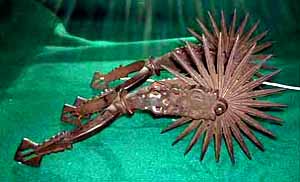
In many cases, the horsemen who came with the Spanish to
the New World were Arabs—Moors,
specifically, from their six-hundred year presence in Spain. Although
they had converted (rather than die), they were still outsiders. So
they took their exemplary horsemanship and gear—like the spur I
had found or
la Jineta, the Muslim cavalry saddle—and signed on for
a new life in a new world. audemars piguet replica watches
California was full of Moorish presence but people didn’t
notice.
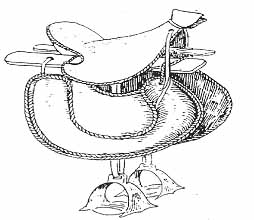
La Jineta, the
Muslim cavalry saddle.
As
an archeologist, nine-tenths of my work is to notice (a product of wondering).
Plus, don’t forget, our team name at El Fornio High School was
the Moors.
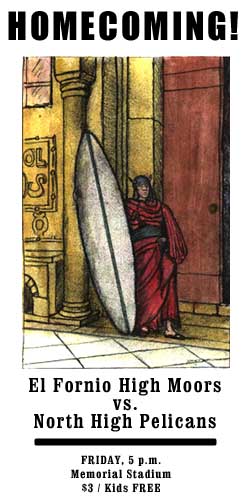
I became even more interested in the notion of Arabic influence in California
through the rise of anti-Arab sentiment in the early 1980s, while I
was an undergrad at UCSB.
Much like the contemporary conservative, misplaced disdain
for France—a country that underwrote our revolution and gifted
us the Statue of Liberty,Replica Handbags where both Franklin and Jefferson lived and
learned to drink wine—people began bashing Arabs while continuing
to use Arabic words, concepts, place names and foods, without even knowing
it.
While in the greater Los Angeles area, if you’re going
to drive your Cadillac Seville to Alhambra from Malaga Cove to get ice
cream while your daughter studies her algebra, you are riding the coat
tails of Arabic influence in California.
Do you want to stop for alcohol at the Oasis Lounge with
the Moorish tile work?
Yes, “alcohol” is an Arabic word (the fifth essence),
and the tile work is part of Islam’s prohibition on narrative face
and body depiction. Think of all that tight geometry wrought so wonderfully
in the name of Allah up and down the coast of California. Build me a
movie theater.
It didn’t come from Ireland.
Last year I bought a black and white photo at the swap
meet of Fritz Lang,
the German exile film director. He’s sat between two gentlemen
in suits, each wearing a Fez, one with the outright word “Islam”
embroidered on the frontispiece of his columnar cap.
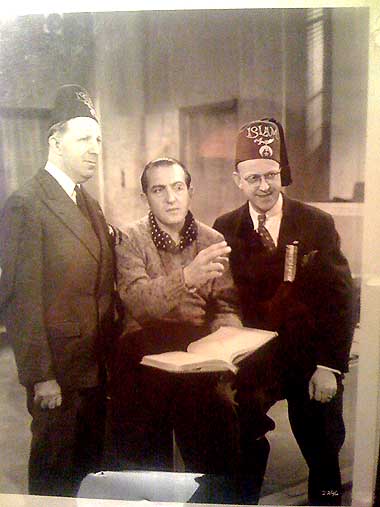
Fritz Lang, the
movie director, sits between two "Shriners," a.k.a.
members of “The Ancient Arabic Order of the Nobles of the Mystic
Shrine”
They are Shriners, also known as The Ancient Arabic Order
of the Nobles of the Mystic Shrine. And mostly likely Freemasons.
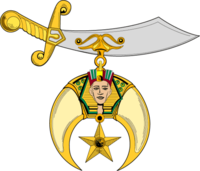
The Shriners got their start in 1870, after one of its
founders, William J. Florence, a rather successful actor in his day,
saw a play put on by an Arabic diplomat in Marseilles. As a Mason, Florence
thought it would be fun to mimic some of the Islamic imagery and structure
he saw in the piece for the secret fraternity which, as an offshoot
of the Masons, he and another Mason brother sought to create. Through
the organization, their thinking went, relationships between men of
certain ethnicities for both fundraising and business activities might
flourish.
Every hear of the Shrine
Auditorium in Los Angeles?
Auditorium
was a term landed upon only after the casual use of the words “temple”
and “mosque” were used by—let’s slog through it
again—“The Ancient Arabic Order of the Nobles of the Mystic
Shrine.”
Eventually the terms “temple” and “mosque”
were abandoned. But the thematic work was done. While this was many
years before Edward Said developed his theory of Orientalism where “The
Other” is made to be exotic, even fictionalized, because they
are inherently not known, the Shriners, like the spur in the mud, were
another example of the overlooked presence of the Armies of Mohammed
in California.
I walked
the spur back to the car, rinsed it off with water and headed to the
historical society to show Lo.
You
never know, it might belong to one of her relatives.
|

